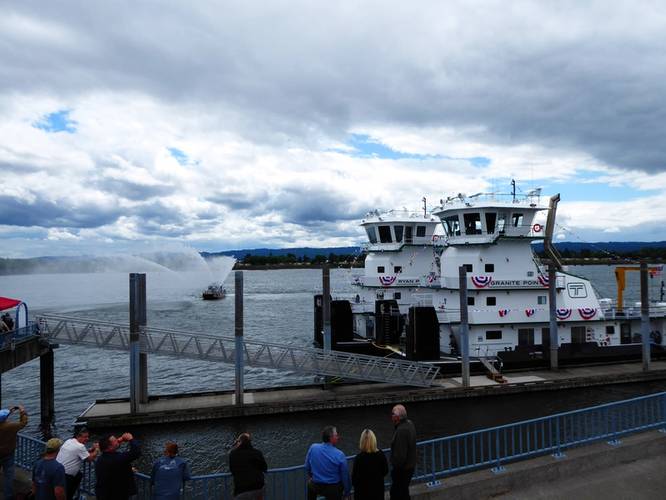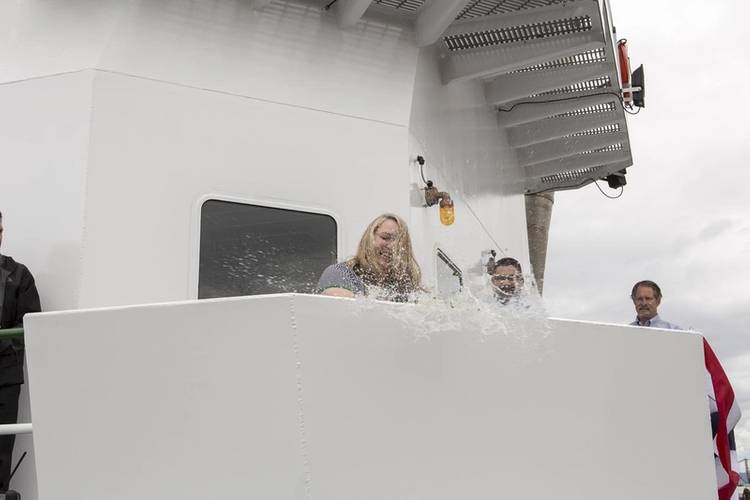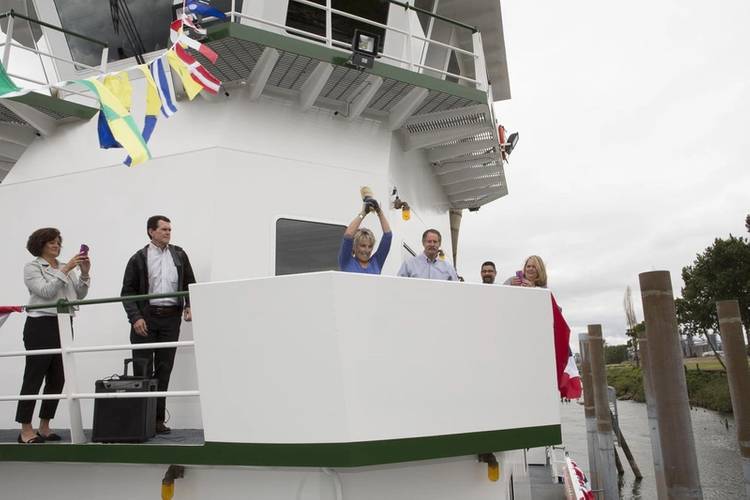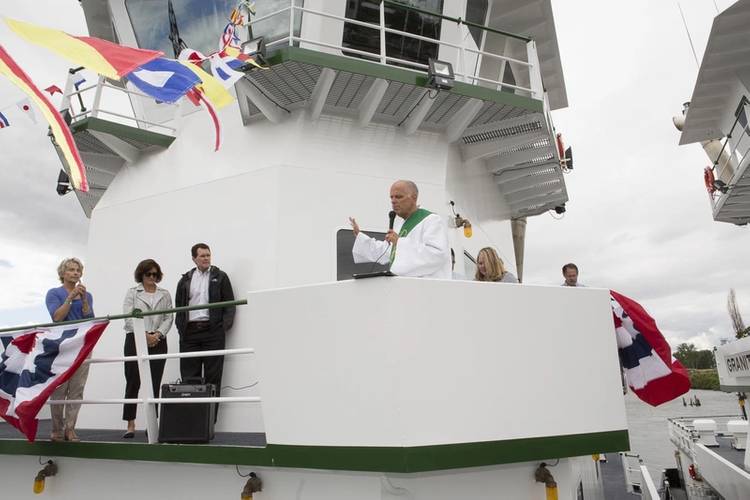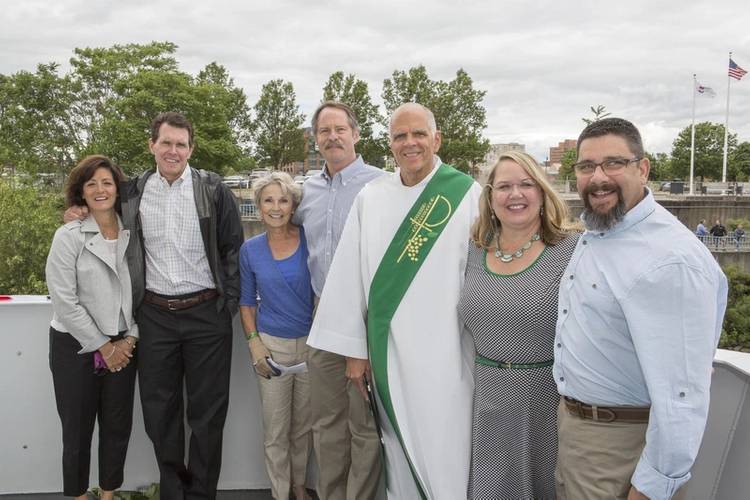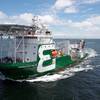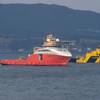The two newest inland river towboats in Tidewater Transportation and Terminals’ fleet, Granite Point and Ryan Point, were christened during a late afternoon ceremony Saturday, June 11 at Vancouver Landing in Vancouver, Wash.
After Deacon Tim Dooley from Portland’s Holy Family Parish delivered a blessing, Patty Reed, wife of Bruce Reed, Tidewater’s Vice President and Chief Operations Officer, and Diane Laya, wife of Marc Schwartz, Tidewater’s Maintenance and Engineering Manager, broke champagne bottles over the vessels’ hull while the City of Vancouver’s fire boat sprayed Columbia River water in the background.
“This celebration is the culmination of three years of research, design and hard work,” expressed Marc Schwartz, Tidewater’s Maintenance & Engineering Manager. “We began the Point Class project with a visionary belief that we could create a vessel that efficiently serves our customers along the river, is environmentally-friendly, and is outfitted with crew endurance in mind. I believe we accomplished our goal.”
Three years ago, Tidewater retained the services of CT Marine, Naval Architects and Marine Engineers of Edgecomb, Maine, to design a towboat that can maneuver barges through the swift-moving currents, high winds, and eight navigation locks along the Columbia Snake River System. Once the plans were developed, Tidewater contracted with Vigor’s Portland shipyard to construct the series of vessels, returning propulsion-construction to Swan Island, and partnered with Umpqua Bank’s Equipment Leasing and Finance Division to finance the two tugs.
“The crews that operate these boats say that there is no tug that they have ever operated that gives the operability that these boats have. They are absolutely perfect,” said Bob Curcio, Tidewater CEO, during the christening ceremony. “From the designing it, the building it, the helping buying it, and finally the operating it, thanks to everyone that made it happen. It’s one hell of a proud day for all the Tidewater folks.”
“It’s been a great source of pride for the Vigor team to build these three tugs,” expressed Corey Yraguen, Executive Vice President of Fabrication. “These boats will be on the river after all of us are likely gone from this earth. That is an astounding thought – that they will be creating jobs and will be a part of the economic engine of our community for a very long time. Thank you Tidewater and all of you who are associated with these great companies that make these kinds of cool things happen.”
Tracy Kruse, Vigor Production Superintendent, emphasized how very different this project was for him and the Vigor team, “This project was local. These tugs are going to be part of the landscape of the northwest for decades to come. Friends and associates who know I worked on the Point Class series will call me up and say, ‘hey, I just saw the Crown Point pushing a barge down the river.’ The pride is something we, as a community, can all share in.”
The first vessel in the series, Crown Point, was christened in June of 2015 and has been in operation for over a year. The Granite Point recently began journeying upriver, and the Ryan Point will follow suit in early July.
All three vessels are built to the same specifications - 104 (length) by 38 feet (beam), with a depth at full load of 11 feet, and a hexagonal wheelhouse with floor-to-ceiling windows on all six sides. An enhanced steering system utilizing four main steering and four flanking rudders, coupled with two Caterpillar 3516C Tier 3 engines, allowed the design team to increase the margins of safety and efficiency. With crew endurance being a priority, Tidewater employed Noise Control Engineers of Billerica MA to develop a sound and vibration control package for the vessel. By incorporating Christie and Grey vibration control mounts and comprehensive acoustic insulation, noise levels register at less than 60 decibels in the accommodations during vessel operation – which is equivalent to an air conditioner.
Tidewater and their collaborative partners spent a great deal of time conceiving and engineering the plans used for all three vessels. The final product has been recognized globally. WorkBoat Magazine and Marine Log, named Crown Point as one of the Best and Most Significant Work Boats of 2015.
“The Point Class towboats stand out amongst other towboats along the river,” stated Bruce Reed. “The vessels are a true testament to the dedication and pride of the entire shipbuilding team at Tidewater and Vigor.”
Tidewater has serviced clients from the mouth of the Columbia River to Lewiston, Idaho for nearly 85 years. The names of the tugs reflect this Tidewater tenet – honoring the past, committed to the future. Crown Point was named for the majestic promontory on the Columbia River Gorge, approximately 15 miles east of Portland, Oregon; Granite Point was named for the significant granite cliff in Washington, about 20 miles southwest of Pullman along the Snake River; and Ryan Point was named after the scenic bend in the Columbia River (Washington State side) about one mile upstream from the I-5 Bridge.
At 104 feet in length and with a beam of 38 feet, each Point Class towboat is powered by two Caterpillar 3516C EPA Tier 3 certified diesel engines producing 2,240 BHP, each at 1,600 RPM. The engines drive two 92” x 100” fixed pitch, stainless steel propellers through CT28 Kort Nozzles capable of a service speed of 8 knots. Operating in the Columbia River Gorge high winds, extreme currents and swells can be considered normal piloting conditions. For this reason an enhanced steering system utilizing four steering and four flanking rudders was designed.
Electrical power is provided by two C7.1, Tier 3 generators, rated at 480v, 200KW at 1,800 RPM. The generators are controlled through an automatic transfer system that ensures the vessel will recover from a generator power loss in less than 30 seconds. Deck machinery includes seven Patterson WWP 65E-7.5, 65 ton electric deck winches, with pilot house remote operation and local push button control stations on the main deck. Each winch has Samson 1 3/8” Turbo 75 Synthetic Line.
In order to utilize the newest technology and minimize power usage, variable frequency drives were used in all major rotating machinery applications and LED lighting was employed in both interior and exterior lighting applications. The vessel is fitted with a Kidde NOVEC 1230 fire suppression system and fire detection in both the machinery spaces and accommodations.








